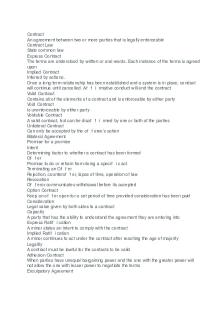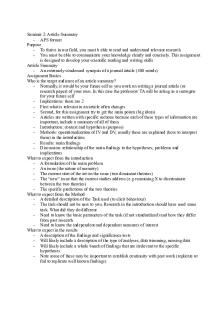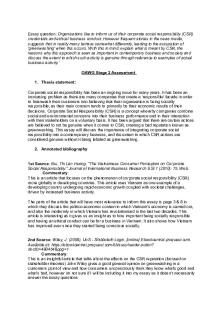Notes 2 - noptes PDF

| Title | Notes 2 - noptes |
|---|---|
| Course | Network Fundamentals |
| Institution | University of Technology Sydney |
| Pages | 9 |
| File Size | 113.2 KB |
| File Type | |
| Total Downloads | 99 |
| Total Views | 132 |
Summary
noptes...
Description
Week 6 Review Suppose Host A sends two TCP segments back to back to Host B over a TCP connection. The first segment has sequence number of 90, the second has sequence number of 110. ● How much data is in first segment? 20 bytes ● If first segment = lost but second segment arrives at B. In ACK that Host B sends to Host A, what will be ACK number? 90 ack number If Host A sends one segment with sequence number of 38 and bytes of data over a TCP connection to Host B. In this same segment the ack number is 42. ● FALSE! If Host A is sending a large file to Host B over a TCP connection. The number of UACK bytes that A sends cannot exceed the size of the receive buffer. ● TRUE! If last sampleRTT in a TCP connection is equal to 1 sec. Current value of timeout interval for the connection will necessarily be >1 sec. ● FALSE! TCP segment has a field in its header for rwnd. ● TRUE! Size of TCP rwnd never changes throughout the duration of the connection. ● FALSE! Host A sending Host B a large file over a TCP connection. Assume Host B has no data to send Host A. Host B will not send ACK to Host A because Host B can’t piggyback the ACK on data. ● FALSE! Congestion control in TCP. When timer expires at the sender, the value of ssthresh is set to one half of its previous value. ● FALSE!
Week 7
Review Internet Stack Protocol: 1. Application = Message Application Data 2. Transports = Segment Transport header
Application Data
3. Network = Datagram IP
Transport header
Application Data
4. Link = Frame Frame header
IP Transport header
Application Data Frame Trailer
5. Physical = Bit Routers Vs. Link-Layer Switch: ● Router = forwards packet based on packets IP address. ● Link-Layer switch = forwards packet based on packets MAC address. Data plane Vs. Control plane: ● Data plane = main function is packet forwarding, specifically forward datagrams from their input links to their output links. ● Implemented in hardware because requires fast processing (operates at nanoseconds). ● Control plane = main function is routing, determining the paths a packet takes from its source to destination. ● Usually in software (operates at milliseconds and seconds). ● 2 approaches: ○ Traditional (Monolithic) routing protocols used by routers to build forwarding tables. ○ Software defined networking (SDN) - external controller creates forwarding tables and sends them to the routers. Routing Vs. Forwarding: ● Routing = refers to network-wide process that determines the end-to-end paths that packets take from sources to destinations. Takes place on much longer timescales (seconds).
● Forwarding = a router’s local action of transferring packets from its input interface to its output interface. Usually takes place at very short timescales (nanoseconds). Forwarding table within a router: ● Forwarding table = hold entries to determine the outgoing link interface that an arriving packet will be forwarded via switching fabric. Network layer service model (UDP) ● Service model of internet’s network layer = best effort service. ● No guarantee that packets will be received in order sent. ● No guarantee of their eventual delivery. ● No guarantee on delay or bandwidth. Input port, output ports, switching fabric and a routing processor: ● Input port, output ports and switching fabric are implemented in hardware, because their datagram-processing functionality is far too fast for software implementation. ● Routing processor inside a traditional router uses software implementation, maintaining routing tables and attached link state information and computing the forwarding tables of a router. Destination based forwarding Vs. Generalized forwarding: ● Destination = datagram arriving at a router will be forwarded to an output interface based on only final destination of the datagram. ● Generalized = besides final destination, other factors associated with datagram also considered when router determines output interface for datagram. ○ Software defined networking (SDN) uses generalised forwarding. Three types of switch fabrics ● Switching via memory ● Switching via bus ● Switching via interconnection network: can forward packets in parallel as long as all packets = being forward to different output ports. Each input port in high-speed router stores shadow copy of forwarding table ● Shadow copy = forwarding lookup is made locally at each input port, without invoking centralised routing processor. This decentralized approach avoids creating a lookup processing bottleneck at a single point within the router. HOL blocking:
● HOL blocking occurs at the input port. ● Packet that is first in line at an input port queue must wait because there is no available buffer space at the output port where it wants to be forwarded. ● When this occurs all packets behind the first packet are blocked, even if their output queues have room to accommodate them. Week 8 Review Example: Host A sends Host B a TCP segment encapsulated in an IP datagram. When Host B receives the datagram how does the network layer in Host B know it should pass the segment to TCP rather than UDP? It will know through the TTL (Time to live) and protocol field in the IP header. Route aggregation: ● Means that an ISP uses a single prefix to advertise multiple networks. ● Useful because an ISP can use this technique to advertise to the rest of the internet a single prefix address for the multiple networks that the ISP has. Plug-and-play or Zeroconf protocol: ● Able to automatically configure a host’s network-related aspects in order to connect the host into a network. Field used to ensure packet is forwarded through no more than N routers: ● Time-to-live Large datagram is fragmented into small datagrams, where are small datagrams reassembled? ● Destination is where fragments are reassembled. Routers have IP addresses. How many? ● One for each interface. Router and DHCP: ● Wireless router includes DHCP server. ● DHCP = used to assign IP addresses to the 5 PCs and to the router interface. ● Wireless router also uses NAT as it obtains only one IP address from the ISP. Generalized forwarding Vs. Destination-based forwarding: ● Generalized = match can be made over multiple header fields associated with different protocols at different layers in the protocol stack.
● Destination-based = match operation of a router looks up only the destination IP address of the to-be-forwarded datagram. Week 9 Review Forwarding Vs. Routing: ● Forwarding = per router function. ● Process of deciding what interface to send a packet out of. ● Implemented in hardware. ● Time takes place in nanoseconds. ● Routing = network wide function. ● Process of building up forwarding table (used by router to decide where to forward packet). ● Implemented in software. ● Takes place seconds (possibly many). Control plane based per-router control: ● Per-router control = routing algorithm runs in each and every router, both forwarding and routing function are constrained within each router. Network control & data planes implemented monolithically: ● Monolithically = each router create forwarding tables themselves. Control plane that is based on logically centralized control: ● Logically centralized control = logically central routing controller computes and distributes the forwarding tables to be used by each and every router, and each router does not compute its forwarding table, unlike per-router control. ● Logically centralized control, data and control plane = implemented separately. Centralized Vs. distributed routing algorithm: * ● Centralized = computers the least-cost path between source and destination by using complete, global knowledge about the network. ● Distributed = calculated least-cost path in an iterative, distributed manner by the routers. With decentralized algorithm, no node has the complete information about the cost of all links. Link-state Vs. Distance Vector: ● Link-state = Consider faster links when forwarding. ● Distance vector = minimise number of hops.
Count-to-infinity problem: ● Problem of distance vector routing. The problem means it takes a long time for distance vector routing algorithm to converge when there is a link cost increase. Necessary for autonomous system to use same intra-AS routing algorithm: ● No, each AS has administrative autonomy for routing within an AS. Week 10 Review Inter-AS Vs. Intra-AS protocol: * ● Autonomous system (AS) = running set of routers that are under same protocols, same administrations and technical control. ● Introduced for scaling and policy. ● Inter = external ○ Exchange of packets between AS. ○ BGP (border gateway protocol) ● Intra = a single domain ○ Exchange of packets within AS. ○ OSPF (Open shortest path first)= link state. OSPF route: ● Router broadcasts its link-state information to all other routers in the AS that it belongs to, not just its neighbouring routers. ● OSPF = each router needs to construct complete topological map of entire AS and then locally runs Dijkstra’s shortest-path algorithm to determine its least-cost paths to all other nodes in same AS. Area in OSPF AS: ● Refers to set of routers, which each router broadcasts its linkstate to all other routers in the same set. ● OSPF AS can be configured hierarchically into multiple areas, with each area running its own OSPF link-state routing algorithm. ● Within each area, one or more area border routers are responsible for routing packets outside the area. ● Concept of area is introduced for scalability reasons. Subnet: ● Dividing a network into two or more networks.
Prefix: ● IP divided into two logical parts network prefix and host identifier. BGP route: ● Standard exterior gateway protocol designed to exchange routing and reachability info in AS. How does BGP use NEXT-HOP and AS-PATH attribute: ● NEXT-HOP indicates the IP address of the first router along an advertised path (outside of the AS receiving the advertisement) to a given prefix. ● When configuring its forwarding table, a router uses the NEXT-HOP attribute. ● AS-PATH to detect and present looping advertisements, they also use it in choosing among multiple paths to the same prefix. BGP router: ● Can choose to add its own identity to the received path and then send that new path on to all of its neighbours, as BGP is policy-based routing protocol. Four different types of ICMP messages ● Echo reply (to ping), type 0, code 0. ● Destination network unreachable, type 3, code 0. ● Destination host unreachable, type 3, code 1. ● Source quench (congestion control), type 4, code 0.
Two types of ICMP messages = received at sending host executing traceroute program: ● ICMP warning message (type 11, code 0) ● Destination port unreachable ICMP message (type 3, code 3) SNMP Terms (Simple Network Management Protocol): ● Managing server = an application, running in centralized network management station in network operation center. Controls collection, processing, analysis and network management information. ● Managed device = a piece of network equipment that resides on a managed network. (must be host, router, switch, middlebox, modem, thermometer) ● Network management agent = a process running in a managed device that
communicates with a managing server, taking loca actions at the managed device under the command and control of the managing server. ● MIB (Management Information Base) = collects the information associated with those managed objects in a managed network. Purpose SNMP GetRequest & SetRequest messages: ● GetRequest = message sent from a managing server to agent to request the value of one or more MIB objects at the agents managed device. ● SetRequest = message used by a managing server to set the value of one or more MIB objects in a managed device. Purpose SNMP trap message: ● Generated as a response to an event happened on a managed device for which device management server requires notification. Week 11 Review Possible services Link-layer protocol can offer to network layer: ● Framing (IP & TCP) ● Link access ● Reliable delivery (TCP) ● Flow control (TCP) ● Error detection (IP & TCP) ● Error correction ● Full duplex (TCP) Polling & token-passing protocols: ● Polling = Master node allows only one node to talk at a time, each node gets a chance to use line but in round-robin fashion. ● Token-passing = no master node rather there is a token passed from node to node and the node with the token is the only one allowed to use line. Week 12 Review How big is MAC address space: ● 48 bits or 2 to power of 48. ● E.g. A5:B6:04:29:38:F0 (Hexadecimal)
How big is IP address space: ● Min 0 & max 255 ● E.g. 192. 168.1. Xxx ← each part can be from 0 - 255. IPv4: ● 32 bit or 2 to power of 32. IPv6: ● 128 bit or 2 to power of 128.
VLAN: ● Group of devices on one or more LANs that are configured to communicate as if they were attached to the same wire. But are actually located on number of different LANs or segments of LAN. Maximum number of VLANs that can be configured on a switch supporting the 802.1Q protocol? ● 802.1Q there is 12 bit VLAN identifier. Thus, 2 to power of 12 = 4096 VLANs can be supported.
All three Ethernet technologies have identical frame structures: ● 10BASE-T ● 100BASE-T ● Gigabit-Ethernet...
Similar Free PDFs

Notes 2 - noptes
- 9 Pages

MNB1501-Notes-2 - NOTES
- 24 Pages

2 - Lecture notes 2
- 5 Pages

Notes 2
- 6 Pages

Notes 2
- 17 Pages

2 - notes
- 11 Pages

Notes 2
- 3 Pages

2 Biodiversity - Lecture notes 2
- 33 Pages

Chapter 2 - Lecture notes 2
- 30 Pages

Blaw 2 - Lecture notes 2
- 4 Pages

Chapter 2 - Lecture notes 2
- 4 Pages

Seminar 2 - Lecture notes 2
- 2 Pages

Stage 2 - Lecture notes 2
- 3 Pages

Micro 2 - Lecture notes 2
- 18 Pages

2 Sources - Lecture notes 2
- 4 Pages
Popular Institutions
- Tinajero National High School - Annex
- Politeknik Caltex Riau
- Yokohama City University
- SGT University
- University of Al-Qadisiyah
- Divine Word College of Vigan
- Techniek College Rotterdam
- Universidade de Santiago
- Universiti Teknologi MARA Cawangan Johor Kampus Pasir Gudang
- Poltekkes Kemenkes Yogyakarta
- Baguio City National High School
- Colegio san marcos
- preparatoria uno
- Centro de Bachillerato Tecnológico Industrial y de Servicios No. 107
- Dalian Maritime University
- Quang Trung Secondary School
- Colegio Tecnológico en Informática
- Corporación Regional de Educación Superior
- Grupo CEDVA
- Dar Al Uloom University
- Centro de Estudios Preuniversitarios de la Universidad Nacional de Ingeniería
- 上智大学
- Aakash International School, Nuna Majara
- San Felipe Neri Catholic School
- Kang Chiao International School - New Taipei City
- Misamis Occidental National High School
- Institución Educativa Escuela Normal Juan Ladrilleros
- Kolehiyo ng Pantukan
- Batanes State College
- Instituto Continental
- Sekolah Menengah Kejuruan Kesehatan Kaltara (Tarakan)
- Colegio de La Inmaculada Concepcion - Cebu
